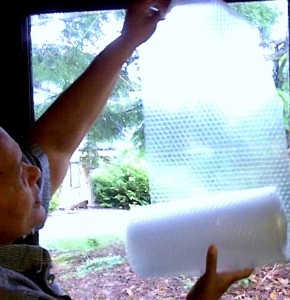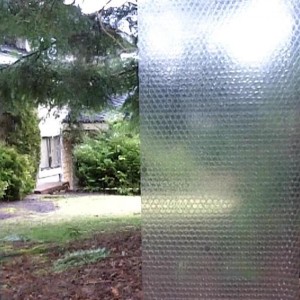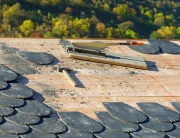It’s February, and the tail end of a long, cold winter that just keeps giving and giving and giving…snow and ice, and wind, that is. Nevertheless, it isn’t too late to winterize your home, especially if you take advantage of this incredibly easy, inexpensive (and genius!) idea contributed to See Jane Drill by one of our members, Tim Olson of Lancaster, Pennsylvania. Tim tells us that this idea, which we will call “The Bubble-Wrap Method” of insulating one’s house, saves him an average of $225 – $325 per MONTH on his heating bill for a 2000 square foot home. And the best part is, when Leah tried this method herself, she discovered that it took 5 minutes or less to insulate each window, for simply the cost of a roll of bubble wrap.
Here is exactly what Tim said:
“So I have an idea that we discovered recently that can save folks on
limited budget money, and keep folks that can’t afford anything fancy warm
in the winter. The idea is window and door winterizing. I’m not talking
about the stretch on and shrink single layer plastic product on the market
today; I’m talking bubbles.
Thermopane widows work on the principle of entrapped air acting as
insulation. The same is true of any insulation; fiber glass, foam, etc.
The trick is to make the amount of entrapped air small. Lots of little
bubbles works better than one big bubble. Stretching film across a widow
for insulation makes a large bubble of entrapped air. It works.
Unfortunately it’s hard for our grandmothers to do, or for that matter, any
of our loved ones that are less than mechanically inclined or not so good on a
step ladder. Here’s where the idea we discovered really shines.
First go to an office supply store and buy a roll of 3/16″ x 12″ x 20′
bubble wrap. It might be called bubble pack. The 3/16″ number is the size
of the bubble. This product comes in multiple bubble sizes and colors.
The 3/16″ and clear is what is needed.”
Tim then shared with us three possible methods of applying the bubble wrap to the windows. Leah tried Method 3, the easiest method, and it worked perfectly!!! See the instructions below:
Method 3 – Simplest
Cut a piece of bubble wrap the size of the glass of an inside window. If
the window is wider than 12″ it may take multiple pieces. Wipe the glass
with a wet sponge [water]. The bubble wrap has one flat side and one side
with bubbles. Lay the flat side on the wet glass, pat it down softly until all of it is flat and it will stick. Cutting to fit is important because it will fall off if it is on the window frame. The sticking with water part relies on it being perfectly flat on the glass. It creates a suction effect
and will hold it there all winter.
If you need to look out the window, peel off the bubble wrap look and then stick it
back on later.
For those of you who have storm windows, or if you have small children or pets that you want to keep away from the bubble wrap, you might also consider Methods 1 and 2 of insulating the windows with the wrap:
Method I
Cut a dowel the width [right to left] of the space between the inner and
outer windows. Cut a piece of string and make a loop 2 1/2 times the
length of the dowel. Cut a small groove in either end of the dowel so it
can catch the string in the dowel and make a triangle. Drape bubble wrap
over the dowel the height of the window [multiple pieces depending on the
width of the window] – no string yet. Then put the loop on the dowel with
the string over the top of the bubble wrap. Open the inside window at
the top and bottom and feed another length of string through, top to bottom,
and hook it to the loop with a paper clip. A friend is useful here, it’s a
team effort. Then pull the bubble wrap up between the inside and outside
windows. At the top, pull the string off, pull the dowel out and close the
window. The bubble wrap is trapped in-between the two windows and the
widow becomes warmer than a thermopane window, because it’s got lots of small
pockets of air bubbles.
Method II
Take the storm window off and staple the bubble wrap to the inside and put
it back on. Strips of cardboard will stop the staples from cutting through the
bubble wrap.
The only drawback to the bubble wrap insulation method is not being able to see through the window. So you may not want to insulate every window in the house. But the great thing about this method is that the sunlight and warmth still come through the windows. Anyone with a sponge, a scissors and roll of bubble wrap can do this and literally save hundreds on your monthly heat bill!
Thanks again, Tim for your fantastic contribution!
We hope everyone keeps warm during the rest of this winter,
See Jane Drill







